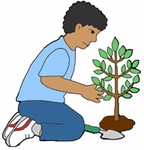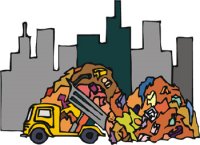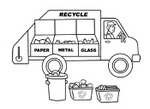
Worksheets and No Prep Teaching Resources
Reading Comprehension Worksheets
Caring for Earth

Caring for Earth
 Worksheets and No Prep Teaching Resources Reading Comprehension Worksheets Caring for Earth |
 Caring for Earth |
| edHelper's suggested reading level: | grades 8 to 10 | |
| Flesch-Kincaid grade level: | 9.45 |
|
A Mountain of Garbage
By Trista L. Pollard |

|
 1 "Two hundred eight million, two hundred nine million, two hundred ten million...." That is the amount of solid waste hitting the bottom of garbage cans all over the United States. Solid waste is the materials that are discarded or thrown away after use by consumers and businesses. This does not include fluid materials. During a single year, Americans throw away 210 million tons (about 4.3 pounds/2 kilograms per person daily) of garbage. We throw away 12.4 million tons of glass and about 80 million tons of paper products. Americans also throw away tons of food scraps, yard wastes, plastics, sludge from sewage treatment plants, and other materials. That is a mountain of garbage!
1 "Two hundred eight million, two hundred nine million, two hundred ten million...." That is the amount of solid waste hitting the bottom of garbage cans all over the United States. Solid waste is the materials that are discarded or thrown away after use by consumers and businesses. This does not include fluid materials. During a single year, Americans throw away 210 million tons (about 4.3 pounds/2 kilograms per person daily) of garbage. We throw away 12.4 million tons of glass and about 80 million tons of paper products. Americans also throw away tons of food scraps, yard wastes, plastics, sludge from sewage treatment plants, and other materials. That is a mountain of garbage! |
Create Weekly Reading Books
Prepare for an entire week at once! |
| Leave your feedback on A Mountain of Garbage (use this link if you found an error in the story) |
 |
Caring for Earth
|
 |
High School Reading Comprehensions and High School Reading Lessons
|
 |
Recycle and Recycling Activities, Worksheets, Printables, and Lesson Plans
|
 |
Earth Day Activities, Printables, Worksheets, and Lesson Plans for Kids
|
 |
Science
|